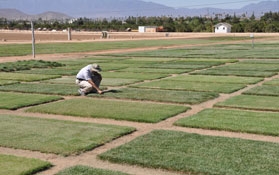
Posts Tagged: landscape
Landscape trees also suffer drought consequences

Igor Lacan, UCCE advisor in Santa Clara, Contra Costa and Alameda counties, says it's difficult to make blanket statements about which species are in trouble, since a tree's water- and heat-related health depends on its location.
Some species on a south-facing slope might show drought stress, while the same species on a north-facing slope doesn't. Stress symptoms also show up on trees planted near paved surfaces, though not near other surfaces that don't reflect heat, Lacan said. Since many tree species are fairly resilient, damage comes on slowly and may take months or years to become apparent.
But Lacan was able to conclude with a positive comment.
"The good thing is that in all likelihood mature, established trees, if climatically appropriate (for their location), will make it through ... just fine," Lacan said.
Programs teams to meet Nov. 13-14
The Ornamental & Environmental Horticulture, Nurseries & Master Gardener Program Team and the Water Resources Program Team will meet on Nov. 13-14, 2013 at the Putah Creek Lodge in Davis. Workgroups will meet on Nov. 12.
Registration and draft agendas will be available soon. Possible agenda topics include new positions, trainings and any agenda suggestions you may have.
Please send suggestions for the agendas to Janet Hartin at jshartin@ucanr.edu or Doug Parker at doug.parker@ucop.edu.
Workgroups interested in holding meetings in conjunction with these program teams, or at any other time this fall, should complete the meeting request form at https://ucanr.edu/survey/survey.cfm?surveynumber=7922. The Program Support Unit will be happy to coordinate.
For all other questions, please contact ANR Program Support Unit.
View or leave comments for ANR Leadership.
This announcement is also posted and archived on the ANR Update pages.
Water-efficient plants highlighted at turfgrass event

Fall is the perfect time to plant native perennials
There are many good reasons to plant California native plants in the landscape, and right now is a good time to do so, according to an article that ran over the weekend in the Sacramento Bee.
Native plants attract beneficial insects and birds, use up to 75 percent less water than conventional shrubs and lawn, require less work and are resistant to pests.
In September and October, the soil is warm enough in most parts of California to encourage native plant's root growth and winter rain will irrigate the new plants. The plants will be ready to produce abundant flowers in the spring, the article said.
Gardeners worried that native plants could appear weedy may wish to visit one of the University of California's native plant displays, including:
- The Honey Bee Haven on the UC Davis west campus
- The UC Davis Arboretum
- Garden of the Sun in Fresno
- Fair Oaks Horticulture Center
A number of UC training sessions about incorporating native plant's in California landscapes are planned:
Napa County, Sept. 15
Sutter-Yuba counties, Sept. 15
Placer-Nevada counties, Sept. 18
Fresno County, Oct. 2

Honey bee on tidy tips, a native California wildflower. (Photo by Kathy Garvey)
UC farm advisor reminds readers to check for hazardous trees
Cooler, breezy weather in California this week is a welcome sign of autumn. After three years of drought, the beginning of fall holds hope for a "normal" rainy season. Since the hoped-for stormy weather can release branches from trees, UC Cooperative Extension horticulture advisor Michelle LeStrange reminded readers in her Visalia Times-Delta column today to take a close look at their landscape trees.
"It’s better to find a broken branch in your tree," she wrote, "than on your car."
She suggests trees be inspected before and after storms for leaning, weakly attached multiple trunks, a split where large branches attach to the trunk, cavities or decay (mushrooms on the tree or roots can be a sign), cracks, broken and dead branches.
LeStrange, the Master Gardener advisor for Tulare County, pointed out a photographic guide produced by UC Cooperative Extension titled “Recognizing Tree Hazards,” which is available at UCCE offices for $4 and free on the Web.

Hazardous-tree.